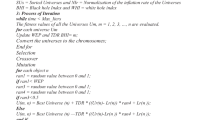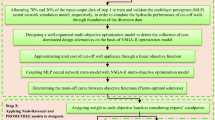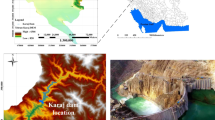Abstract
A novel risk-based multi-objective compromise methodology was proposed for selective withdrawal from a dam reservoir. Developed for devising a five-year optimal reservoir policy in dry, wet, and normal periods, it allowed for selective water withdrawal from multiple outlets at different depths to account for the reservoir's water quality and thermal stratification. A calibrated version of the CE-QUAL-W2 numerical model was utilized for simulating temperature and other water quality parameters at different reservoir outlets under possible scenarios of reservoir inflow and outflow. To address the computational burden problem, two multilayer perceptron meta-models were trained and validated using the CE-QUAL-W2 simulation results for temperature and the IRan Water Quality Index (IRWQI) at each reservoir outlet. Then, the validated meta-models were coupled with the non-dominated sorting genetic algorithm-II (NSGA-II) optimization technique, allowing one to incorporate different stakeholders’ utility functions. Three objective functions were considered: (i) minimization of the storage deficit risk, (ii) minimization of the low water quality risk (due to reservoir thermal stratification), and (iii) minimization of the deficit between total releases and demands. Finally, the GMCR-plus model resolved stakeholder conflicts and achieved a compromise solution. Alleviating the shortcomings of previous models in achieving coupled water quality-quantity allocation by drawing on the capabilities of conditional value-at-risk (CVaR) and graph models, along with NSGA-II, constituted the present study’s principal contribution. The research findings revealed that applying the proposed methodology could provide adequate water quality corresponding to different demands during thermal stratification to prepare effective guidelines for optimal reservoir operation.








Similar content being viewed by others
Data Availability
Not applicable.
Code Availability
Not applicable.
Notes
Corps of Engineers-QUALity-Width averaged 2D (CE-QUAL-W2).
References
Bennett ND, Croke BF, Guariso G, Guillaume JH, Hamilton SH, Jakeman AJ, ... Andreassian V (2013) Characterising performance of environmental models. Environ Model Softw 40:1–20
Cole TM, Wells SA (2006) CE-QUAL-W2: A two-dimensional, laterally averaged, hydrodynamic and water quality model, version 3.5
Deb K, Agrawal S, Pratap A, Meyarivan T (2000) A fast elitist non-dominated sorting genetic algorithm for multi-objective optimization: NSGA-II. p. 849–858. In: Schoenauer M. et al. (eds) Parallel Problem Solving from Nature PPSN VI. PPSN 2000. Lecture Notes in Computer Science, vol 1917. Springer, Berlin, Heidelberg. https://doi.org/10.1007/3-540-45356-3_83
Deb K, Pratap A, Agarwal S, Meyarivan TAMT (2002) A fast and elitist multiobjective genetic algorithm: NSGA-II. IEEE Trans Evol Comput 6(2):182–197. https://doi.org/10.1109/4235.996017
Dowlatabadi N, Banihabib ME, Roozbahani A, Randhir TO (2020) Enhanced GMCR model for resolving conflicts in a transboundary wetland. Sci Total Environ 744:140816
Ghodsi SH, Kerachian R, Malakpour Estalaki S, Nikoo MR, Zahmatkesh Z (2016) Developing a stochastic conflict resolution model for urban runoff quality management: Application of info-gap and bargaining theories. J Hydrol 533:200–212. https://doi.org/10.1016/j.jhydrol.2015.11.045
Giuliani M, Lamontagne JR, Reed PM, Castelletti A (2021) A state-of-the-art review of optimal reservoir control for managing conflicting demands in a changing world. Water Resour Res 57(12):e2021WR029927
IWPC (Iran Water and Power Resources Development Co) (2010) Systems approach to Karkheh River Basin water resources projects (Available in Persian). Technical Report, IWPC Research Department, Tehran, Iran
Khorshidi MS, Nikoo MR, Sadegh M, Nematollahi B (2019) A multi-objective risk-based game theoretic approach to reservoir operation policy in potential future drought condition. Water Resour Manage 33(6):1999–2014. https://doi.org/10.1007/s11269-019-02223-w
Mabaya G, Unami K, Fujihara M (2017) Stochastic optimal control of agrochemical pollutant loads in reservoirs for irrigation. J Clean Prod 146:37–46
Madani K (2010) Game theory and water resources. J Hydrol 381(3–4):225–238. https://doi.org/10.1016/j.jhydrol.2009.11.045
Mallakpour I, AghaKouchak A, Sadegh M (2019) Climate-induced changes in the risk of hydrological failure of major dams in California. Geophys Res Lett 46(4):2130–2139. https://doi.org/10.1029/2018GL081888
Masoumi F, Afshar A, Palatkaleh ST (2016) Selective withdrawal optimization in river–reservoir systems; trade-offs between maximum allowable receiving waste load and water quality criteria enhancement. Environ Monit Assess 188(7):390. https://doi.org/10.1007/s10661-016-5386-0
MGCE (Mahab-Ghodss Consulting Engineering) (2011) Integrated soil and water study in Karkheh River Basin. [In Persian.] Tehran, Iran: Ministry of Energy
Monghasemi S, Nikoo MR, Khaksar Fasaee MH, Adamowski J (2017) A Hybrid of genetic algorithm and evidential reasoning for optimal design of project scheduling: A systematic negotiation framework for multiple decision makers. Int J Inf Technol Decis Mak 16(2):389–420. https://doi.org/10.1142/S0219622017500079
Mooselu MG, Nikoo MR, Sadegh M (2019) A fuzzy multi-stakeholder socio-optimal model for water and waste load allocation. Environ Monit Assess 191(6):359. https://doi.org/10.1007/s10661-019-7504-2
Nikoo MR, Khorramshokouh N, Monghasemi S (2015) Optimal design of detention rock fill dams using a simulation-based optimization approach with mixed sediment in the flow. Water Resource Manage 29(15):5469–5488. https://doi.org/10.1007/s11269-015-1129-1
Oweis TY, Siadat H, Abbasi F (2009) Improving on-farm agricultural water productivity in the Karkheh River Basin. CPWF Project Report-Project Number 08: CGIAR Challenge Program on Water and Food; Department for International Development: Chatham, UK
Raei E, Nikoo MR, Pourshahabi S (2017) A multi-objective simulation optimization model for in-situ bioremediation of groundwater contamination: Application of bargaining theory. J Hydrol 551:407–422. https://doi.org/10.1016/j.jhydrol.2017.06.010
Rheinheimer DE, Null SE, Lund JR (2015) Optimizing selective withdrawal from reservoir to manage downstream temperature with climate warming. J Water Resour Plan Manag 141(4):04014063. https://doi.org/10.1061/(ASCE)WR.1943-5452.0000447
Saadatpour M, Afshar A, Edinger JE (2017) Meta-model assisted 2D hydrodynamic and thermal simulation model (CE-QUAL-W2) in deriving optimal reservoir operational strategy in selective withdrawal scheme. Water Resour Manag 31(9):2729–2744. https://doi.org/10.1007/s11269-017-1658-x
Sechi GM, Zucca R (2015) Water resources allocation in critical scarcity conditions: A bankruptcy game approach. Water Resour Manag 29:541–555. https://doi.org/10.1007/s11269-014-0786-9
Shukla S, Wood AW (2008) Use of a standardized runoff index for characterizing hydrologic drought. Geophys Res Lett 35(2)
Soleimani S, Bozorg-Hadad O, Saadatpour M, Hugo AL (2016) Optimal selective withdrawal rules using a coupled data mining model and genetic algorithm. J Water Resour Plan Manag 142(12):04016064. https://doi.org/10.1061/(ASCE)WR.1943-5452.0000717
Tayebikhorami S, Nikoo MR, Izady A, Adamowski J (2020) A novel CVaR-based conflict resolution model for optimal allocation of treated wastewater under bankruptcy conditions. J Clean Prod 252:119766
Vanda S, Nikoo MR, Bakhtiari PH, Al-Wardy M, Adamowski JF, Šimůnek J, Gandomi AH (2022) Reservoir operation under accidental MTBE pollution: A graph-based conflict resolution framework considering spatial-temporal-quantitative uncertainties. J Hydrol 605:127313
Zhang X, Liu P, Xu CY, Ming B, Xie A, Feng M (2018) Conditional value-at-risk for nonstationary streamflow and its application for derivation of the adaptive reservoir flood limited water level. J Water Resour Plan Manag 144(3):04018005
Zhao Q, Cai X, Li Y (2019) Determining inflow forecast horizon for reservoir operation. Water Resour Res 55(5):4066–4081
Zhou Y, Xu X, Li M, Zhang X, Cao K (2022) Risk regulation of water allocation in irrigation areas under changing water supply and demand conditions. J Environ Manag 313:114945
Author information
Authors and Affiliations
Contributions
All authors contributed to the study's conception and design. Conceptualization, methodology, software, investigation, and review and editing were performed by S. Vanda, M.R. Nikoo, N. Taravatrooy, G. Al-Rawas, S.M.K. Sadr, F.A. Memon, and B. Nematollahi. The first draft of the manuscript was written by S. Vanda, and all authors reviewed and edited previous versions and approved the final manuscript.
Corresponding author
Ethics declarations
Ethical Approval
All authors approved ethical standards and consented to participate in and publish this manuscript.
Consent to Participate
Not applicable.
Consent to Publish
Not applicable.
Conflict of Interest
The authors declare that they have no known competing financial interests or personal relationships that could have appeared to influence the work reported in this paper.
Additional information
Publisher's Note
Springer Nature remains neutral with regard to jurisdictional claims in published maps and institutional affiliations.
Supplementary Information
Below is the link to the electronic supplementary material.
Rights and permissions
Springer Nature or its licensor (e.g. a society or other partner) holds exclusive rights to this article under a publishing agreement with the author(s) or other rightsholder(s); author self-archiving of the accepted manuscript version of this article is solely governed by the terms of such publishing agreement and applicable law.
About this article
Cite this article
Vanda, S., Nikoo, M.R., Taravatrooy, N. et al. A Novel Compromise Approach for Risk-Based Selective Water Withdrawal from Reservoirs Considering Qualitative-Quantitative Aspects. Water Resour Manage 37, 4861–4879 (2023). https://doi.org/10.1007/s11269-023-03584-z
Received:
Accepted:
Published:
Issue Date:
DOI: https://doi.org/10.1007/s11269-023-03584-z




